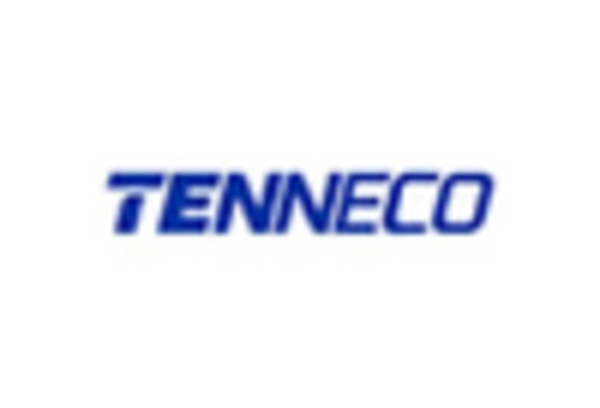Increasing Environmental Regulations
The Automotive Exhaust Emission Control Device Market is experiencing a surge in demand due to stringent environmental regulations imposed by various governments. These regulations aim to reduce harmful emissions from vehicles, thereby promoting cleaner air and public health. For instance, regulations such as Euro 6 in Europe and Tier 3 in the United States mandate lower nitrogen oxides and particulate matter emissions. As a result, manufacturers are compelled to invest in advanced emission control technologies, which drives the market forward. The increasing focus on sustainability and environmental protection is likely to further bolster the demand for emission control devices, as compliance with these regulations becomes non-negotiable for automotive manufacturers.
Government Incentives for Clean Technology
Government incentives aimed at promoting clean technology are significantly influencing the Automotive Exhaust Emission Control Device Market. Various countries are offering tax rebates, subsidies, and grants to manufacturers and consumers who invest in low-emission vehicles and technologies. These incentives not only encourage the adoption of cleaner vehicles but also stimulate innovation in emission control technologies. For instance, programs that support the development of hydrogen fuel cell vehicles are gaining traction, which could lead to a new wave of emission control devices tailored for these technologies. As governments continue to prioritize environmental sustainability, the market for emission control devices is likely to expand.
Technological Innovations in Emission Control
Technological advancements play a pivotal role in shaping the Automotive Exhaust Emission Control Device Market. Innovations such as selective catalytic reduction (SCR) systems and advanced particulate filters are enhancing the efficiency of emission control devices. These technologies not only help in meeting regulatory standards but also improve vehicle performance. The market for SCR systems is projected to grow significantly, with estimates suggesting a compound annual growth rate of over 6% in the coming years. As automotive manufacturers increasingly adopt these cutting-edge technologies, the demand for sophisticated emission control devices is expected to rise, reflecting a shift towards more efficient and environmentally friendly vehicles.
Global Shift Towards Sustainable Transportation
The Automotive Exhaust Emission Control Device Market is benefiting from a broader global shift towards sustainable transportation solutions. This transition is driven by a combination of factors, including urbanization, rising fuel prices, and the need for energy efficiency. As cities become more congested, there is an increasing emphasis on reducing vehicular emissions to improve air quality. The market for emission control devices is expected to grow as automotive manufacturers respond to this demand by integrating advanced technologies into their vehicles. Furthermore, the push for sustainable public transportation systems is likely to create additional opportunities for emission control device manufacturers, enhancing market prospects.
Rising Consumer Demand for Eco-Friendly Vehicles
The Automotive Exhaust Emission Control Device Market is witnessing a notable shift in consumer preferences towards eco-friendly vehicles. As awareness of environmental issues grows, consumers are increasingly seeking vehicles that produce lower emissions. This trend is evident in the rising sales of electric and hybrid vehicles, which often incorporate advanced emission control technologies. According to recent data, the market for electric vehicles is anticipated to reach a substantial share of total vehicle sales by 2030. Consequently, automotive manufacturers are investing in emission control devices to cater to this evolving consumer demand, thereby driving growth in the market.


















Leave a Comment